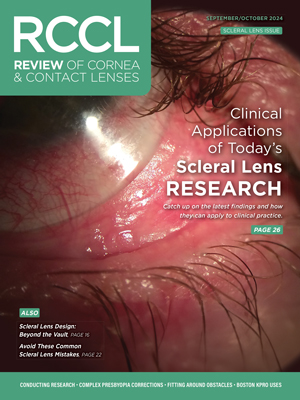 If you ask patients who have discontinued lens wear why they decided to stop wearing their lenses, most will undoubtedly cite lack of comfort as the main reason. This is true for lens modalities across the board—both gas-permeable (GP) and soft. Gas-permeable lenses provide us with an infinite combination of powers, so theoretically, we can provide clear vision for any patient. One would think that the same would be true for comfort. But, while it is theoretically possible to provide an ideal fit for every patient, unfortunately even a perfect fit does not guarantee that every patient will be comfortable 100% of the time. The three components that have significant influence on lens comfort are physical, physiological and psychological; furthermore, contact lens discomfort fits into two categories—acute and chronic.
If you ask patients who have discontinued lens wear why they decided to stop wearing their lenses, most will undoubtedly cite lack of comfort as the main reason. This is true for lens modalities across the board—both gas-permeable (GP) and soft. Gas-permeable lenses provide us with an infinite combination of powers, so theoretically, we can provide clear vision for any patient. One would think that the same would be true for comfort. But, while it is theoretically possible to provide an ideal fit for every patient, unfortunately even a perfect fit does not guarantee that every patient will be comfortable 100% of the time. The three components that have significant influence on lens comfort are physical, physiological and psychological; furthermore, contact lens discomfort fits into two categories—acute and chronic.
A lens that provides slight apical clearance with a light touch in the mid-periphery yields the most comfortable lens-to-cornea relationship, which allows for lens movement and good centration. Edge lift, which is determined by the base curve in combination with intermediate and peripheral curves, should offer enough clearance to provide a reservoir of tears for exchange on blinking; the edge lift must not be excessive, however, as that will irritate the lids and inhibit blinking.
Acute and Chronic Discomfort
Etiology of acute onset discomfort can be mechanical, where a foreign body becomes trapped beneath the lens, potentially resulting in damage to the corneal surface. This usually does not require treatment beyond removing the foreign body and discontinuing lens wear until the cornea heals. Lenses with mild scratches can frequently be resurfaced or polished to restore a smooth, wettable surface. But, a lens defect such as a severely scratched surface or a chipped lens requires further intervention. A chipped lens needs to be replaced—as does a severely scratched lens.
Poor edge design can cause acute and chronic discomfort issues. A lens edge that is too thick and/or poorly shaped will continue to interact with the lids, which causes irritation. A lens such as this can be reedged in-office or returned to the lab to be refabricated. If the lens is adjusted in-office, the lab still needs to be informed of the less-than-ideal quality of the lens. This is why it’s important to look carefully at the entire circumference of the lens, rather than taking a quick glance at one side of the lens.
Acute lens discomfort can also be a consequence of sensitivity to the solutions used. While this is more common among soft lens wearers, it does happen with GP wearers. It is best to provide the patient with a prescription rather than a suggestion for the solution the patient must use. If a problem arises, prescribe a different solution, one that is comprised of different chemicals, especially preservatives, than the original solution that caused sensitivity.
Chronic lens discomfort can also be the result of solution sensitivity. Some of us are under the impression that the patient will tolerate a little redness and a little discomfort because that is natural with contact lens wear. That school of thought is just plain wrong! We should do everything within our power to address issues of discomfort; otherwise our patients will surely stop wearing their lenses. Whenever dealing with chronic lack of comfort, try changing the solution first.
Another reason for discomfort is a dry or soiled lens surface. Because the lens becomes soiled gradually, the lens wearer may not notice this until the lens is quite dirty. Usually such eyes are somewhat injected and wearing time may be decreased. This problem can be solved by a good lens cleaning. If you have the proper equipment, polishing/resurfacing a lens is a quick and simple process. If you do not, Progent is a very good substitute. In most cases, patients will feel the difference as soon as the lens is back on the eye.
Provide Safe and Comfortable GP Wear
The psychological aspect of GP lens comfort begins with the original fitting. Practitioners should never use words such as “discomfort” or “pain,” using terms “awareness of the lens” or “sensation” instead. Be positive, but make sure that all lens wearers know that if comfort seems to decrease over time, they must contact your office so you can remedy the problem quickly. By paying attention to details and having a treatment plan with multiple options, it is realistic for virtually all of our GP lens wearers to have many years of safe and comfortable lens wear.


